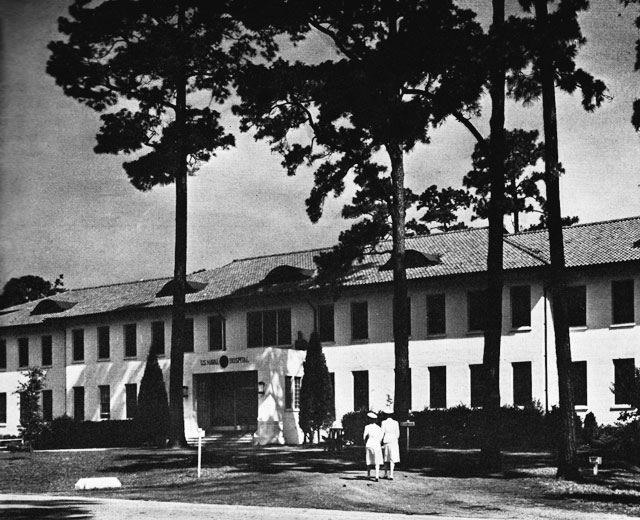
Naval Hospital Charleston in 1948. U.S. Navy photo.
Staff reports | The National Trust for Historic Preservation has named the Charleston Naval Hospital District in North Charleston to its 2016 list of Americas 11 Most Endangered Historic Places.
The annual list spotlights important examples of the nation’s architectural and cultural heritage that are at risk of destruction or irreparable damage. More than 260 sites have been on the list over its 29-year history, and in that time, only a handful of listed sites have been lost.
“This is the place where the wounded warriors of the Greatest Generation were repaid by a grateful nation,” said North Charleston resident Don Campagna, vice commander of the Charleston Commandery of the Naval Order of the United States. [See pictures of the buildings in the district.]
Dating to 1902 and chiefly constructed by the Works Progress Administration (WPA) in 1938, the Charleston Naval Hospital District was completed just in time for the outbreak of World War II. The Naval Hospital District is one of three National Register Districts on the site of the former Charleston Navy Base and played a prominent role during the warI, serving as the primary re-entry point for American servicemen injured in Europe and Africa. As many as 4,000 wounded soldiers were received and treated here every month.
According to a news release, the Naval Hospital District features a landscape designed by the office of renowned landscape architect Frederick Law Olmsted and a hospital with a layout that reflects important contemporary advances in military medicine. The main hospital building was constructed with specialized wings to include psychiatric care, reflecting the growth of medical specializations.
Located in the rapidly-developing area of North Charleston, the Naval Hospital District currently sits primarily vacant, with only a few outlying buildings in use. Impending construction of a rail line proposed by Palmetto Railways, extending the length of the district, calls for the demolition of nine of the 32 buildings that make up the district, and would seriously hinder the reuse of 19 others. Not only would the rail line result in the destruction of integral buildings within the Naval Hospital District, which could cause a de-listing from the National Register, the release said it would also diminish the potential ability for adaptive reuse of the complex as a vibrant community space.
“The Charleston Naval Hospital District is an incredibly important historic resource that has been underappreciated for far too long,” said Stephanie Meeks, president of the National Trust for Historic Preservation. ”We believe there is a solution and, indeed, a great opportunity to incorporate the site as a vibrant and integral part of the larger North Charleston community.”
- Learn more about endangered sites here: www.SavingPlaces.org/11Most
In other good news:
Remember coming weekend’s Big Book Sale. The Charleston Friends of the Library will present That Big Book Sale for free on Oct. 14 to Oct. 16 at the Omar Shrine Auditorium in Mount Pleasant. More than 60,000 unique books, DVDS, CDs, audiobooks, sheet music, and maps will be available to purchase for prices as low as $.50. Proceeds from the event will help support more than 6,000 free community programs offered through the Charleston County Library system.
- For more information visit www.charlestonlibraryfriends.org or call 843-805-6882.
 In the South China Sea. Petty Officer 3rd Class Monteco Salley, a sailor at right from Charleston, surveyed the horizon on Oct. 3 using “big eyes” binoculars aboard amphibious assault ship USS Bonhomme Richard (LHD 6) during a replenishment at sea (RAS). Bonhomme Richard, flagship of the Bonhomme Richard Expeditionary Strike Group, is operating in the South China Sea in support of security and stability in the Indo-Asia Pacific region. (U.S. Navy photo by Petty Officer 3rd Class Jeanette Mullinax/Released)
In the South China Sea. Petty Officer 3rd Class Monteco Salley, a sailor at right from Charleston, surveyed the horizon on Oct. 3 using “big eyes” binoculars aboard amphibious assault ship USS Bonhomme Richard (LHD 6) during a replenishment at sea (RAS). Bonhomme Richard, flagship of the Bonhomme Richard Expeditionary Strike Group, is operating in the South China Sea in support of security and stability in the Indo-Asia Pacific region. (U.S. Navy photo by Petty Officer 3rd Class Jeanette Mullinax/Released)
Small business exports. South Carolina has a new pool of $333,364 of funding from the U.S. Small Business Administration (SBA) to support export growth among small businesses, according to a news release. The funding was awarded through SBA’s competitive State Trade Expansion Program (STEP).
STEP funds allow small businesses the opportunity to meet foreign buyers face-to-face at trade shows or on trade missions, and complement SBA’s export loan guaranty programs, which can finance the working capital needed to complete export orders and in turn help finance the expansion of production facilities due to export success. Loans are available up to $5 million. More information can be obtained from SBA’s Export Finance Managers located at 21 U.S. Export Assistance Centers across the country.
New tourism website. North Charleston shares its attractions, destinations and food scene in the city’s first-ever tourism website at www.visitnorthcharleston.com. A distinctive story is revealed through the website, one that showcases unique locations and entertainment previously untold to the Lowcountry’s 5 million visitors.



 We Can Do Better, South Carolina!
We Can Do Better, South Carolina!
























